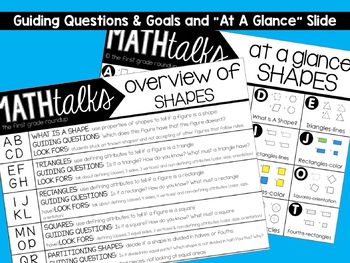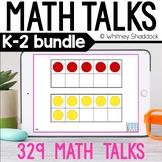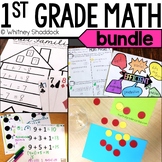2D and 3D Shapes Math Talks Printable AND Digital
- Zip
What educators are saying
Also included in
- Young learners make sense of their math world and numbers by talking about it! Number Talks give your K-2 kids ways to talk purposefully about numbers, addition, subtraction, fact families, true or false equations, shapes, linear measurement and data graphs. In this large number talks bundle you wPrice $29.00Original Price $38.00Save $9.00
- It's hard to find a 1st grade math curriculum that is rigorous AND engaging! Look no further! This first grade guided math curriculum has 1st grade math lesson plans already written for you plus all the materials needed to implement guided math workshop right away.WHY GUIDED MATH WORKSHOP?Many teachPrice $159.00Original Price $221.00Save $62.00
Description
First graders make sense of their math world and numbers by talking about it! These printable and digital 2D and 3D shapes math talks give your kids ways to talk purposefully about 2D shapes, 3D shapes, and the geometry standards for K-2.
Get your students comfortable with identifying properties of shapes, recognizing shapes partitioned in halves or fourths, and using defining and non-defining attributes to tell whether or not a figure is a triangle, rectangle or square.
Visit my blog for ideas on how I used this in my classroom.
INCLUDED IN PRINTABLE & DIGITAL SHAPES MATH TALKS are slides with purposefully planned figures to get K-2 kids talking about shapes and their properties. There are 4 figures for each "talk" and 20 total talks (that's 80 figures to talk about altogether!). There are 4 planned talks for each of the following categories:
• What is a shape? (properties of shapes)
• Is it a triangle?
• Is it a rectangle?
• Is it a square?
• Which figure is divided in half/fourths? (2 talks for halves and 2 talks for fourths)
This product is available as a DIGITAL interactive powerpoint or PRINTABLE pdf file. Plus, a main menu for easy navigation on each page! (Note: navigation links are only available in the PowerPoint file.)
RELATED RESOURCES:
Tricky Shapes: A Complete Geometry Packet for K-2
More Cognitively Guided Math Resources
RELATED VIDEOS:
What Is A Math Talk? (Intro & Routines)
Copyright Whitney Shaddock, 2019, licensed for one classroom use only. Please use the multiple licensing option for more than one classroom use!
Let's Connect:







